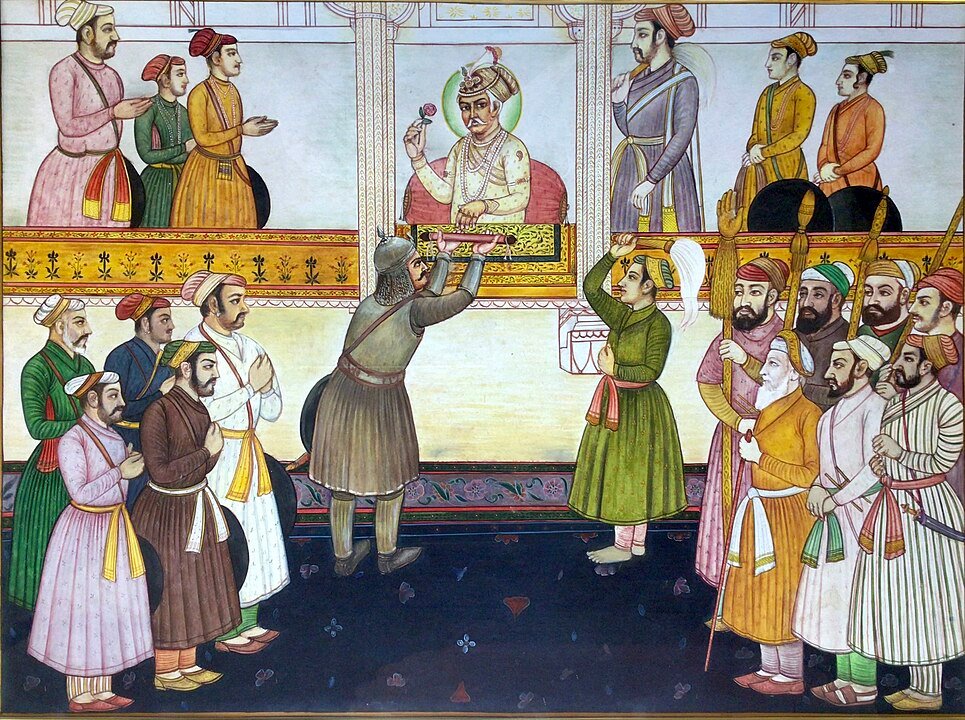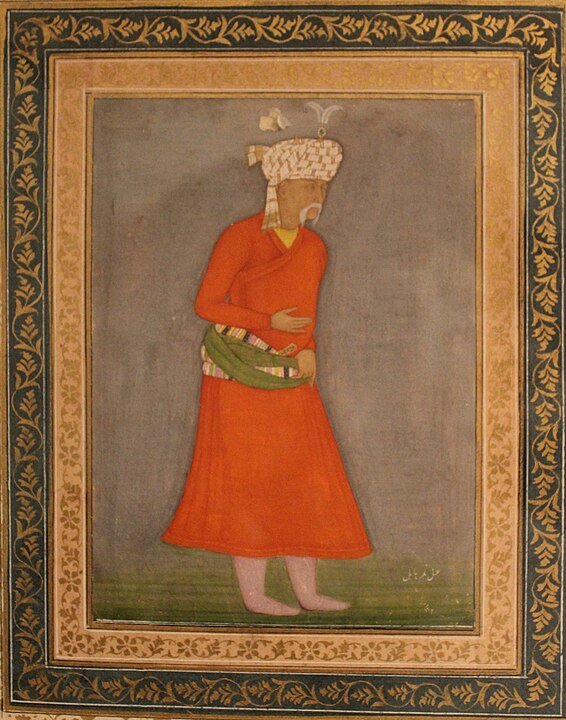Jalal-ud-din Abu’l-Fath Among the most powerful Mughal monarchs was Muhammad Akbar. Akbar, a charismatic leader and accomplished general, progressively expanded the Mughal Empire to encompass a huge portion of the Indian subcontinent. However, because of the Mughals’ supremacy in the military, politics, culture, and economy, his power and influence were felt throughout the whole subcontinent.
Akbar Mansabdari System
“The Mansabdari system, as it developed under the Mughals, was a distinctive and unique
system which did not have any exact parallel outside India”.
In order to determine the status and pay of the Mansabdars (nobles) who served the Mughals, Akbar established the Mansabdari System, an administrative framework, in the Mughal empire in 1571. The military and civil administration of the state served as the foundation for Akbar’s Mansabdari System. The Mansabdar System was a Mughal grading system that determined the pay and position of a Mansabdar.
It was developed by Akbar to manage India’s machinery and revenue system. But under Aurangzeb’s reign, the Mansabdari system had to come to an end. Under the Mughal Empire’s rule, nobility held several ranks in the Mansabdari System hierarchy.
Under Akbar’s Mansabdari System, the Mughal emperor appointed and removed officials according to their relative positions, and their pay reflected this. You can read more about the Mansabdari System of Akbar below, including its history, the way people were ranked, and the reasons behind the system’s collapse.
P. Spear claimed that “it was Elite within Elite.” Every officer was assigned a rank under this system; the lowest rank was 10, and the highest rank was five thousand. There was only one rank at first; but, by the 40th regnal year, there were two ranks: Sawar and Jat.
The Mansabdari System was first implemented when Changez Khan divided his army into units. He had ten lower divisions and 10,000 upper divisions, and the Khans were the leaders of each of these units. Nonetheless, Babur was the one who brought the Mansabdari System to northern India.
However, in 1571, Akbar became the first Mughal emperor to formally establish the Mandabdari System in both the military and civil administration. He presented the ideas of Sawar and Zat. Rather of calling it Mansabdar, he called it Wajahdar, which the Emperor could order to be moved between the public and military sectors. There were 1800 Mansabdars under Akbar’s control, but under Aurangzeb’s reign, that number skyrocketed to 14500.
The Rajput lords and nobles known as mansabdars were chosen by the Mughal emperors to hold both military and civil positions, such as province governors, military commanders, and officers in both the military and the civilian spheres. The Arabic word mansab, which meaning rank, status, or position, originated there.
Under this method, each officer received a mansab. The mansabdars served as the basis for figuring out that specific officer’s pay and benefits. Akbar appointed the Mansabdars on Mirbakshi’s recommendation, even though the Mughal Emperors recruited and promoted the Mansabdars. When they applied for government jobs, there was no racial or religious discrimination.
The individual wishing to join the Mansabdar system had to file a petition through a noble.
The particular noble, then, presents Emperor with a tajwid. According to the records, there were 66 mansabdars’ grades during Akbar’s rule. Perhaps only 33 mansabs out of them were working in practice.
Akbar Jagirdari System
| Jagir | Revenue assignment |
| No hereditary | Rights |
| Different types of jagir | Tankha jagir, Watan Jagir, Inam jagir, Al tamgha Jagir, Mashru jagir. |
The Mansabdari system and Jagirdari system worked properly under Akbar. During the Akbar period, they were allowed to collect, only authorized revenue.

Akbar Land Revenue Reform
Akbar established a legitimate system of land revenue. But the system that Shershah Suri put in place during his brief reign served as the foundation for Akbar’s. Therefore, it may be said that Akbar’s land revenue system was neither an invention nor an innovation. Even if he owes the previous rulers a great deal, his reputation as the creator of the land income system has not decreased.
With greater accuracy and precision, he adopted Shershah’s doctrine and expanded it to include several subahs or regions inside his empire. However, it took some time for this adjustment or precision to occur. It was cruel enough at first to make peasants become vagrants and make them sell their spouses and kids. But it underwent multiple revisions.
The Four categories were as follows:
| Polaj | Throughout the empire, Polaj was the ideal and best type of land. This land was always cultivated and was never left fallow. |
| Parauti | This was the land that was temporarily kept out of cultivation to regain its fertility. |
| Chachar | Chachar was a type of land that was allowed to lie fallow for three or four years before being cultivated again. |
| Banjar | was the worst type of land that had been left uncultivated for five years or more. |
Three groups were created from the best lands, Polaj and Parauti: good, moderate, and bad. Bigha regarded the Mahsul, or average production, of these three groups as normal production. One-third of this Mahsul (average production) was allocated to the state.
The Parauti area, when cultivated, was likewise liable to the Polaj rate (one-third of Mahsul).
Land classified as Chachar was exempt from paying the full Polaj rate until it was once more farmed. Nor were the lands of the Banjar entirely disregarded. The peasants also had the choice of making payments in kind or cash, depending on what was more practical for them.
82% of the total revenue resources of the Empire was appropriate by 1,671 mansabdars, while the top 12 mansabdars controlled as much as 18.52% of the total income of the Empire, the remaining 1,149 mansabdars controlled only 30% of the revenue, thus, there was an immense concentration of revenue resources in the hands of a few persons during the time of Akbar
Shireen Moosvi
Evolution of Religious and Social Outlook
According to J.L Mehta, the exposition of Akbar’s religious policy was not a sudden birth of an idea.
Akbar’s religious views were diverse and unconventional for his time. He was born into a
Muslim family and grew up in a traditional Sunni environment. However, he was exposed
to other faiths, such as Hinduism, Christianity, Zoroastrianism, and Jainism, through his
interactions with scholars, poets, and religious leaders.
Akbar was deeply interested in religion and philosophy and sought to create a new synthesis of faiths that would promote peace and harmony. He believed that no single religion had a monopoly on truth and that all faiths had something valuable to offer. He also saw himself as a spiritual seeker who was above sectarian divisions. To realize his vision of religious pluralism, Akbar adopted several measures that were both radical and controversial. He abolished the “jizya” tax on non Muslims and invited scholars from various faiths to his court to engage in dialogues and debates.
Three groups were created from the best lands, Polaj and Parauti: good, moderate, and bad.
Additionally, he combined parts of Christianity, Zoroastrianism, Islam, and Hinduism to establish a new religion known as Din-i Ilahi, or Divine Faith. It came about as a result of evolution. The pilgrimage tax is eliminated by Akbar in the 1560s. He outlaws the practice of forcing POWs to convert to another religion. He then outlaws the Jaijiya in 1560 as well. In the framework of his connection with Rajput in 1560, he also adhered to a comprehensive policy of religious tolerance.
His hiring of Hindus into his aristocracy in 1560 is another example of his liberal policies. He built the hall of prayer at Fatehpur Shikari, known as Ibadatkhana, in the 1570s. The religious discourse began in Ibadatkhana. It was limited to Muslims at first. It was made available to followers of all faiths. Devi and Purushottam were invited to convert to Hinduism. For Jainism, he invited Har Vijay Suri. Having studied Hinduism extensively, they asked Maharjirana to elucidate Jorastrism.
In an attempt to fortify his stance against varying interpretations of Islam, Akbar released a pronouncement known as Mahazar, which was widely regarded as an infallible decree.
Badayuni claims that Akbar progressively turned away from Islam because he desired to be in charge. Din-e-Ilahi, or Akbar’s code of behavior, was published in the 1580s. It contained guidelines such as
Some of the principles of Din-i-Ilahi Were As Follows:
- Followers of Din-I-Ilahi should believe in one God and should be tolerant towards all
religions. - Every adherent of this faith should be willing to give away property, life, religion, and
honor to the emperor. - Every member should take an oath to do good to everybody.
- No member should have blind faith.
- The following of Din-i-Ilahi should not accept and encourage child marriage as well as
old marriage. - All should lead a life of purity and good moral character.
- Members should respect all faiths.
- Whenever the followers of this faith meet, one should say Allah-hu-Akbar meaning
God is great. In reply, the other should say all-Allah-meaning God is beautiful and
merciful.
There is two View the nature of Din-E-Ilahi.
View 1
1. It was a monument of Akbar’s folly.
2. It was a silly invention.
View 2
Modern scholars rejected this view, and according to them it was a crowning
expression of Akbar’s idea of nationalism. It was a monument of Akbar wisdom. Akbar never becomes the profit and ports. He wanted to give a model for a progressive society.
Satish Chandra suggested that “his Tauhid-e –Ilahi died with him”. This idea was not accepted by many.
Social Outlook of Akbar
He set up a translation department and began translating texts into Persian from Sanskrit and other languages. Additionally, he opposes having numerous wives.
He set the marriageable age. His efforts to change education are likewise well-known. His focus is on moral education. His focus is on mathematics. He places a strong emphasis on secular topics like governmental regulations. The state evolved into a mostly secular, liberal, and enlightened entity under Akbar. His success was not great.
Akbar as a promoter of technology
According to Abul Fazal, he was aware of the discovery of America by Europeans, he called it the new world. Then Akbar had a scientific approach. Akbar periods of also known for big ships. Ship making was also made, according to Abul Fazal’s technique of cooling water. There was a scientist in his court in Agra. His name was Fatullah shirazi. He was known for developing Calendar.
Pre & Mains : Buy History NCERT 11th class by R.S.Sharma for UPSC
History Optional : Buy A History of Ancient And Early Medieval India : From the Stone Age to the 12th Century By Upinder Singh
Feature Image Credit and License :- Wikimedia Commons license
Inline Image Credit and License :- Wikimedia Commons license
